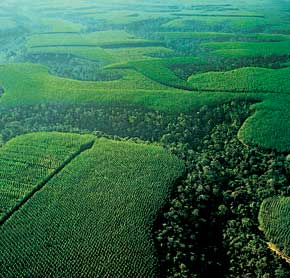The Future
If the current demand for wood flooring continues, future consumers
will surely have even more choices, from an ever-changing lineup of
sources. Increasingly, solid wood will be considered simply as one form
of a natural resource that can be chipped, peeled, ground, sliced, or
otherwise disassembled and then reassembled with adhesives and various
other ingredients.
 |
 |

Orderly rows of Lyptus
seedlings rise on a plantation in South America. It takes only about 15
years for the trees, a hybrid of two eucalyptus species, to be ready
for harvesting.
Photo: Courtesy of Weyerhauser
 |

|
Wood from sustainable forests, grown and harvested under carefully
managed conditions, will be one source of new flooring material. One
example is Lyptus, a natural hybrid of two eucalyptus species being
grown on plantations in Brazil. According to Craig Anderson of
Weyerhaeuser, which imports Lyptus flooring, 120-foot trees can be
harvested about 15 years after planting; by comparison, red oak takes
about 40 years to reach merchantable size, cherry 80 years. In the
future, look for calculated hybridization to yield other options for
fast-growing, renewable
tvoivozhd---as a recalcitrant if incapacitated farmer, this is something I approve of. It doesn't make sense to attempt to "farm" trees that take 200 years to mature. A tree that grows to 150 feet in fifteen years excites my admiration---no "tree farmer" in the Uhited States ever dreamt of such a crop---and its profit potential. The insatiable demand for wood products is not going to diminish,but trees this superior will go a long way toward pluggig the gap. I'm happy you ran across this article---I certainly missed it.
